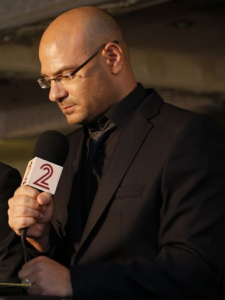Armed with mineral water and a camera, mainstream Israeli media is part of the military

Ohad Hemo
Hanin Majadli writes in Haaretz on 15 November 2024:
Let’s start at the end. Channel 12 broadcast a two-part story on the Gaza Strip, prepared by its Palestinian affairs reporter Ohad Hemo. The story was more like a propaganda campaign. Hemo may have walked around there, microphone in hand, but in facing the poor people he interviewed, surrounded by soldiers armed to the teeth, he was actually there holding a gun to their head, armed with mineral water and a camera.
Gazan residents knew what Hemo was after. They knew he had come to photograph them in the service of propaganda, but they also knew what they needed: water, food, treatment, perhaps a reprieve.
There were flops and distortions from the get-go. Hemo declared that “over a year has passed since October 7, 2023, and now the world is paying attention to Gaza, but no one really knows what is happening there.” A person has to have been comatose throughout the last year to say a sentence like that. The world has been paying attention to Gaza since last October. The world is describing what’s happening there; the world is broadcasting photos and videos; people are talking, crying, ripped up in pain. “No one really knows?” No, Hemo, no one in Israel really wants to know.
This is so because mainstream Israeli media – with Hemo’s Channel 12 being a typical example – are not interested in really covering the war. The media aren’t interested because they aren’t real news media. They are more propaganda outlets than media. They are part of the military, of the IDF spokesman’s story.
“No Western media have really managed to reach Gazans until now and hear them unfiltered,” said the story. Again, these are empty words, countered by the serious investigative reports by The Guardian and The New York Times, for example. Haaretz has also reported numerous items which included quotes by Gazan residents. There have also been interviews with stunned foreign doctors, who left Gaza and talked painfully to numerous Western media about what is happening in that hell. Only Israeli media do not cover this criminal war truly and professionally, out of cowardice and for propaganda reasons.
“In the background one can see thousands of people gathering. After a year they’ve decided that it’s enough, that it’s too dangerous and frightening, that it’s time to leave Jabalya,” said the report. But not a single word about the deliberate withholding of food, about the intense bombardment of a helpless civilian population, aimed at making them leave. There was no word about the hundreds of fatalities in the northern part of the Gaza Strip and the thousands of besieged and hungry people there.
Hemo knows all this, but he prefers to show hungry people who vilify Hamas, not hungry people made hungry by Israel. That’s how it is when you, the interviewer, are hungry for a pat on the back from the guys in the editorial room, in the neighborhood, in the reserves, in the blindly patriotic environment you live in.
One hundred twenty minutes of interviews with people who are disabled and hungry, amputees who are limping in what looks like a march of refugees from one shelled, destroyed location to another, in the company of people who are half-dead, bereft of everything. In this dystopia, Hemo tried to elicit one more sentence against Hamas and another curse against its members, from people begging for water on their death march in the desert, among the ruin and destruction of what used to be their reality. All of this with the army as a backdrop, killing them and forcing them to wander, surrounding them on all sides. Hemo, what would you say if you were in their place?
This article is reproduced in its entirety
